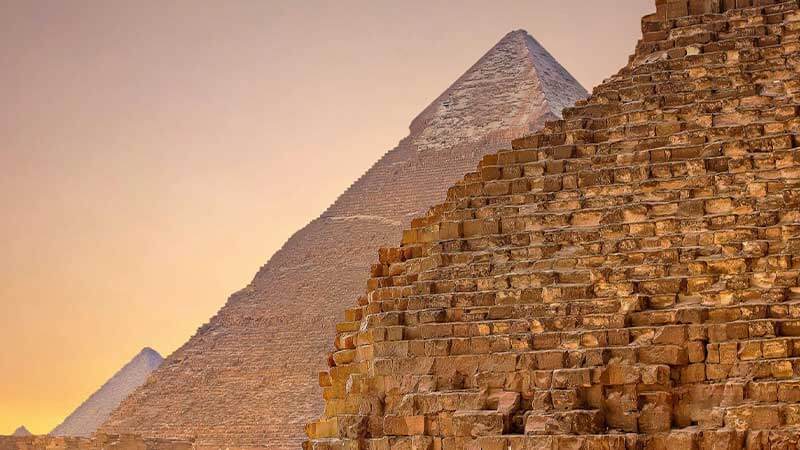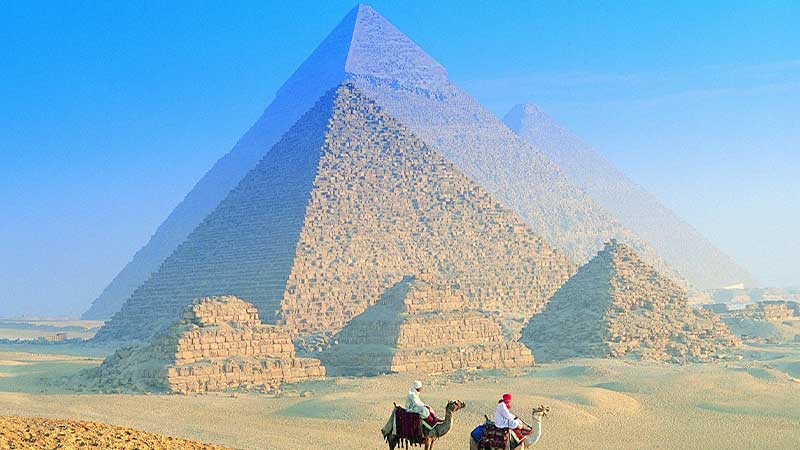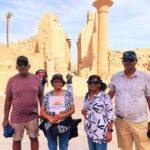The Pyramid of Menkaure, also known as the Pyramid of Mykerinos, is one of the three stunning pyramids on the Giza Plateau in Egypt, along with the Great Pyramid of Khufu and the Pyramid of Khafre. This majestic wonder has fascinated historians, archaeologists, and tourists for centuries. Standing tall with grandeur and mystery, the Pyramid of Menkaure holds a significant place in the history of ancient Egypt and continues to intrigue the world with its enigmatic allure.
The History of the Pyramid of Menkaure
The Pyramid of Menkaure was constructed during the Fourth Dynasty of the Old Kingdom of Egypt, around 2532–2504 BCE. It was built as the tomb for Pharaoh Menkaure, also known as Mykerinos, who was the son of Pharaoh Khafre. Despite being the smallest of the three Giza pyramids, its historical importance is immense, reflecting the culmination of pyramid-building achievements during this era.
The Architecture and Design
The Pyramid of Menkaure was once an architectural marvel, soaring to around 65 meters (213 feet). Its original base measured approximately 108.5 meters (356 feet) on each side. The pyramid’s exterior was encased in polished Tura limestone, gleaming brilliantly under the Egyptian sun. Unfortunately, much of the outer casing is missing, but remnants glimpse the pyramid’s former glory.
Menkaure Pyramid Construction Techniques
The construction of the Pyramid of Menkaure exemplifies the innovative techniques employed by ancient Egyptian architects. It was built using limestone blocks, carefully cut, and transported to the site. The limestone blocks were stacked in layers, creating the pyramid’s smooth and imposing exterior. Within the pyramid, a complex network of passages, chambers, and corridors served as the final resting place for the pharaoh.

The Enigmatic Sphinx Connection
Adjacent to the Pyramid of Menkaure lies the famous Great Sphinx, adding to the site’s allure. The Sphinx, a mythical creature with the body of a lion and the head of a human, has been the subject of countless speculations and theories. The Sphinx may have a significant connection to the Pyramid of Menkaure, and the enigma surrounding both structures continues to captivate historians and researchers.
Sphinx Symbolism in Ancient Egypt
The Great Sphinx symbolizes power, wisdom, and strength, attributes associated with the pharaohs of ancient Egypt. Its proximity to the Pyramid of Menkaure has led to various interpretations of their relationship. Some theories suggest that the Sphinx was a guardian of the pyramids, while others propose more intricate connections between the two structures.
Significance and Purpose
The Pyramid of Menkaure holds immense historical and cultural significance, providing valuable insights into ancient Egyptian funerary practices and beliefs. Like its larger counterparts on the Giza Plateau, the pyramid was constructed to ensure the safe passage of the pharaoh’s soul to the afterlife. The pyramid’s interior chambers were equipped with precious artifacts and offerings to assist the pharaoh in the journey to the realm of the gods.
Religious Beliefs in Ancient Egyptian Afterlife
The ancient Egyptians believed in an afterlife where the souls of the deceased would embark on a perilous journey before reaching eternal paradise. The construction of the Pyramid of Menkaure was crucial in ensuring the pharaoh’s successful transition to the afterlife and continued rule over Egypt, even in death.
Exploring the Inner Chambers
Venturing into the Pyramid of Menkaure reveals its interior’s complex and labyrinthine structure. The pyramid consists of several chambers, including the King’s Chamber and the Queen’s Chamber. The King’s Chamber, located at the heart of the pyramid, houses the pharaoh’s sarcophagus. At the same time, the Queen’s Chamber is believed to be a symbolic space rather than an actual burial chamber.
Giza Pyramid Interior Layout
The interior layout of the Pyramid of Menkaure differs from that of the Great Pyramid of Khufu. Its design indicates an evolution in architectural techniques and concepts. While exploring the pyramid, one can marvel at the precise engineering and the symbolic significance attributed to various chambers.
The Pyramid Complex and Associated Structures
The Pyramid of Menkaure is not just a standalone structure but part of a more extensive complex that includes a mortuary temple, a causeway, and smaller pyramids for royal family members. The mortuary temple served as a place for performing funerary rituals and offering prayers to the pharaoh. The causeway connected the mortuary temple to the Valley Temple, likely used for the pharaoh’s mummification process.
Pyramid of Menkaure Complex Layout
The layout of the entire complex showcases the meticulous planning and organization of ancient Egyptian architects. Each structure had its unique purpose, contributing to the overall funerary process and ensuring the pharaoh’s successful journey to the afterlife.

The Legacy of the Pyramid of Menkaure
Over the centuries, the Pyramid of Menkaure has weathered the test of time, witnessing the rise and fall of empires and inspiring awe in countless visitors. Its enduring presence serves as a reminder of the greatness and ingenuity of ancient Egypt. As one of the most well-preserved old structures, it continues to be a testament to the advanced architectural prowess of the ancient Egyptians.
FAQs
Is the Pyramid of Menkaure open to visitors?
Yes, the Menkaure and the other Giza pyramids are open to visitors. Tourists can explore the exterior and, in some cases, venture into the pyramid’s interior.
What artifacts were found inside the Pyramid of Menkaure?
Archaeologists discovered various artifacts within the pyramid, including a granite sarcophagus, funerary goods, and precious offerings intended to accompany the pharaoh to the afterlife.
How long did it take to build the Pyramid of Menkaure?
The construction of the Pyramid of Menkaure likely spanned several decades, involving thousands of skilled workers.
What is the significance of the Pyramid of Menkaure’s smaller size than the other Giza pyramids?
The smaller size of the Menkaure reflects the changing priorities and resources available during the Fourth Dynasty. Despite its size, its significance and symbolic value were equal to its larger counterparts.
Has the interior of the Pyramid of Menkaure been fully explored?
While much of the pyramid’s interior has been studied, some areas remain restricted to preserve the ancient structure and protect valuable artifacts.
What is the role of the Pyramid of Menkaure in modern times?
Today, the Menkaure remains a prominent historical and cultural landmark, attracting tourists from all over the world and serving as a reminder of the rich heritage of ancient Egypt.
Conclusion
The Pyramid of Menkaure is an enduring testament to ancient Egypt’s grandeur, brilliance, and deep-rooted beliefs. Its construction reflects the dedication and ingenuity of ancient architects, while its purpose as a funerary monument highlights the profound significance of the afterlife in Egyptian culture. Today, this iconic structure inspires awe and admiration, reminding us of the greatness of civilizations that have long passed.




